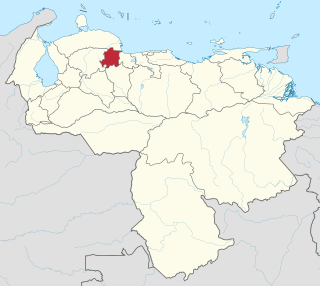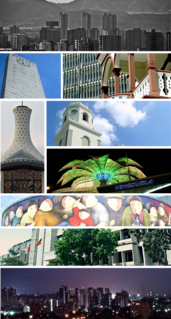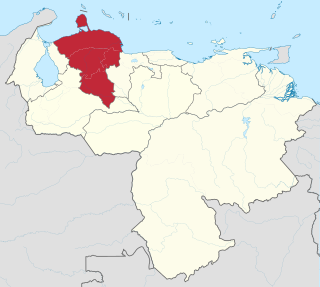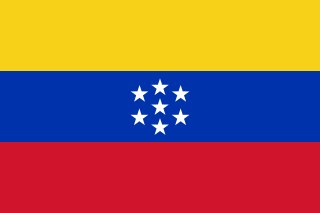
Cojedes State is one of the 23 states of Venezuela. The state capital is San Carlos.

Lara State is one of the 23 states (estados) into which Venezuela is divided. The state capital is Barquisimeto.

Yaracuy State is one of the 23 states of Venezuela. It is bordered by Falcón in the north, in the west by Lara, in the south by Portuguesa and Cojedes and in the east by Cojedes and Carabobo.

Barquisimeto is a city in Venezuela. It is the capital of the state of Lara and head of Iribarren Municipality. It is an important urban, industrial, commercial and transportation center of the country, recognized as the fourth-largest city by population and area in Venezuela after Caracas, Maracaibo and Valencia.

San Felipe is the capital city of Yaracuy, Venezuela. San Felipe's an important urban, industrial, commercial and transportation center of Venezuela. San Felipe is situated in a rich agricultural region of Western Venezuela, and produces many agricultural products for the rest of the country such as sugar cane, milk, livestock, grains, and flour. It's the seat of the Roman Catholic Diocese of San Felipe, Venezuela.

The shrine to Our Lady of Guadalupe was the most important Marian shrine in the medieval kingdom of Castile. The image is enshrined in the Monastery of Santa María de Guadalupe, in today's province of Cáceres in the Extremadura autonomous community of Spain.

The State Railways Institution is a state-run organization of Venezuela that manages the railway systems of the country. Its headquarters are located in Caracas, Venezuela.

The Iribarren Municipality is one of the nine municipalities (municipios) that makes up the Venezuelan state of Lara and, according to a 2007 population estimate by the National Institute of Statistics of Venezuela, the municipality has a population of 1,027,022. The City of Barquisimeto is the shire town of the Iribarren Municipality.

Fort Santa Cruz is one of the three forts in Oran, the second largest port city of Algeria; the other two forts are Fort de la Moune at the western end of the port and Fort Saint-Philippe, a replacement of the old castle of the Saints known in Spanish as Castillo de los Santos, at the centre of Oran. The three forts are connected by tunnels. Fort Santa Cruz was built between 1577 and 1604 by the Spaniards on the Pic d’Aidour above Gulf of Oran in the Mediterranean Sea, at an elevation of above 400 metres (1,312 ft). In 1831, the French occupied Oran and the fort.

The Central-Western Region is one of the 10 administrative regions in which Venezuela was divided for its development plans; it comprises the states of Falcón, Lara, Portuguesa, and Yaracuy.

The Señor de las Tribulaciones is the name given to an image of Jesus Christ that is venerated in the Iglesia de San Francisco de Asís in the city of Santa Cruz de Tenerife.
There have been four different professional baseball clubs in Venezuela that have played under the name Pastora. These teams have been established in the northwest of the country, particularly in the states of Zulia and Acarigua, and have played in different leagues between 1931 and 2000.

The National Shrine of La Virgen Divina Pastora, known canonically as the Three Kings Parish, is a shrine in Gapan City in the Philippines that was founded in 1589. It is one of the oldest Roman Catholic churches in the country, and the oldest and the biggest colonial church in Nueva Ecija. The church has been a pilgrimage site for two patron saints of Gapan and also of Nueva Ecija; the Three Kings, and the Divina Pastora. On April 26, 1986, the Catholic Bishops Conference of the Philippines declared the church as a National Shrine.

The United States of Venezuela was the official name of Venezuela, adopted in its 1864 constitution under the Juan Crisóstomo Falcón government. This remained the official name until 1953, when the constitution of that year renamed it the Republic of Venezuela. In 1999 under newly elected president Hugo Chavez and his modification to the Constitution, Venezuela's official name became the Bolivarian Republic of Venezuela.

Barquisimeto Cathedral is a Roman Catholic cathedral in Barquisimeto, Venezuela. It is one of the most modern cathedrals in Latin America, considered original in style. Designed by Jan Bergkamp, it was his first major project. Its exterior shape is an upside down flower, with a bell tower external to the building. It is located on Avenida Venezuela between Avenida Simón Rodríguez and Calle 30. Considered to be advanced engineering for its time, it was completed in 1968. This unconventionally-shaped cathedral is a hyperbolic paraboloid with two wings connected by a central tower. It required extensive structural precision. The cathedral ceiling consists of acrylic panels supported by a network of steel wires.

The Cathedral of the Divine Shepherdess or Tucupita Cathedral is a religious building that is affiliated with the Catholic Church and serves as the seat of the Apostolic Vicariate of Tucupita created on July 30, 1954, by bull Crescit in dies of Pope Pius XII, and it works in the city of Tucupita, Delta Amacuro state capital at the eastern end of the South American country of Venezuela. It is specifically located between Marino, La Paz and Arismendi Avenue streets.
Divine Shepherdess or Divina Pastora is a title which refers to Mary, mother of Jesus, in connection with Jesus's role as the "Good Shepherd". This title may refer to:
Andrea Carolina del Valle Destongue Quiróz is a Venezuelan model, computer engineer and beauty pageant titleholder who was selected as Miss Supranational Venezuela 2011. Destongue represented Venezuela in the Miss Supranational 2011 competition.
Manuel Eduardo González Mejías is a Venezuelan football manager, currently in charge of Yaracuyanos.





















